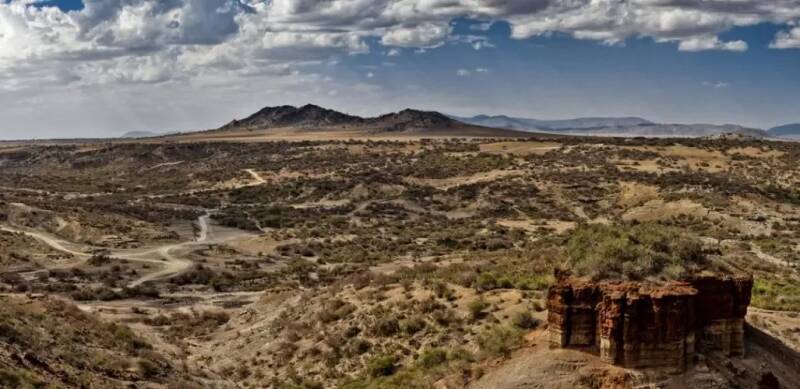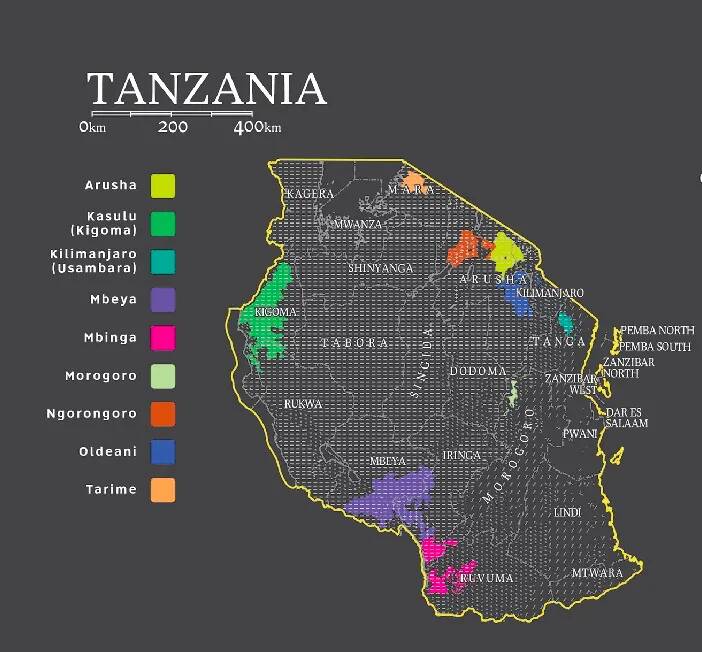Tanzania| Introduction to Mbinga, the coffee producing area
African coffee has an important position in the global coffee market, in which Ethiopia is also the birthplace of coffee, and in addition to Ethiopia, there are many excellent coffee producing countries, such as Kenya, Tanzania and Rwanda.
Tanzania is located in eastern Africa, south of the equator, composed of Tanganyika (mainland) and Zanzibar (island), and adjacent to many African countries.

According to some historical records, coffee was introduced into Tanzania from Ethiopia in the 16th century. By the 19th century, when Germany colonized Tanzania, coffee had become a cash crop such as Tanzania.
Tanzania's economy is dominated by agriculture and is rich in mineral and tourism resources. The topography of the country is high in the northwest and low in the southeast, the eastern coast is a lowland, and the western plateau accounts for half of the total area of the country. The East African Rift Valley runs from east to south from Lake Malawi, with Mount Kilimanjaro, the highest peak in Africa.
The country is close to the equator, so the eastern coast and inland lowlands have a savanna climate, while the western inland plateau has a tropical mountain climate, with an annual average temperature of 21 ℃-26 ℃. Although the country has less rainfall, with less than 1000 millimeters in 80 per cent of the region, Tanzania has many rivers and lakes and is rich in hydropower resources.

Coffee cultivation in Tanzania is currently divided into nine producing areas, with the relatively well-known ones being Kilimanjaro, Arusha, Ruvuma, Mbeya, Tarime and Kighoma. In Tanzania, 90 per cent of coffee is produced by 450000 small farmers, while the other 10 per cent comes from larger estates, so it is dominated by cooperatives. And the first Tanzanian co-operative, Kilimanjaro Native Planters'Association (KNRA), was established in 1925.
Among the coffee producing areas in Tanzania, Kilimanjaro ("Kilima" means mountain and "Zaro" means radiant) is the most famous. Kilimanjaro is the highest mountain on the entire African continent, mainly composed of three extinct volcanoes, Kibo, Mavenz and Sheila, up to 5895 meters, while coffee is grown at an altitude of 1050-2500 meters.
High enough altitude, volcanic soil, and pure snow-melting water are the most suitable areas for growing coffee. On the front street, there is a washed iron pickup from the Kilimanjaro area, which tastes soft and sour, with citrus, berry, honey and nut flavors, soft tea taste and overall balance.
Although Tanzania's boutique coffee-producing areas are concentrated near Mount Kilimanjaro and in the north, southern Tanzania has also come to the fore in recent years, such as the Mbinga region.
The Mbinga region is famous for its proximity to Lake Lake Malawi in Malawi, the third largest lake in Africa, surrounded by mountains on three sides except the south, coffee is grown on a 1600-meter hillside, and the soil is fertile, suitable for agricultural products such as coffee.
The local Nsekewe cooperative can produce high-quality coffee beans because it is one of the few cooperatives in the region with female board members, and it pays great attention to the protection of the environment.
Important Notice :
前街咖啡 FrontStreet Coffee has moved to new addredd:
FrontStreet Coffee Address: 315,Donghua East Road,GuangZhou
Tel:020 38364473
- Prev

How to make espresso Cambaran? What is the ratio of cream to coffee? What is Con panna?
Compared with other fancy coffees, the probability of Cambaolan appearing on the menu of coffee shops is too low. It is not an exaggeration to say that it is an "unpopular product" in the coffee industry. Because of this, Kang Baolan's unique drinking method has not been popularized. When many friends first met Kang Baolan, they followed Afjado's shape
- Next

Eating watermelon while cutting?! COCO shop assistants accused of being unsanitary!
▲ Click to pay attention| Daily Boutique Coffee Culture Magazine Coffee Workshop Yesterday, Star Video released a video saying that some netizens saw employees cutting watermelons while eating them in the process of preparing materials at the Coco milk tea shop. From the video, it can be seen that this employee is an important ingredient in preparing the recently launched watermelon drink. according to
Related
- Is espresso stored overnight in the refrigerator harmful to your body? Is frozen coffee better than freshly ground coffee?
- What parameters and proportions of water temperature should be used to grind and brew fresh coffee beans? Why can't I drink freshly roasted coffee right away?
- Customers have "changed" Manner's new products! Shop assistant: Please don't mess around!
- Remove sockets in customer areas at Starbucks stores?! Netizen: I won't go if I really tear it down
- What is the difference between the taste steps of sun-dried coffee and washed coffee? Why is sun-cured coffee sweeter and washed coffee sour?
- The recipe for salty grapefruit dirty is revealed! Coffee Festival salty grapefruit dirty coffee making materials parameters ratio milk share!
- How about the flavor of Sunlight 74158 at Sidamo Banshaha Mathieu Processing Factory in Ethiopia? 74158 Share the proportion of coffee brewing parameters!
- What effect does Italian American coffee with filter paper have? Will coffee taste better if it is put on filter paper at the bottom of the powder bowl?
- What is the color difference in coffee beans? What are the characteristics of honey processed coffee beans? Why are the anaerobically treated coffee beans uneven in color?
- How does novice Xiaobai quickly get started and make coffee? Newbies learn to make coffee by hand and share the specific steps and process process!

